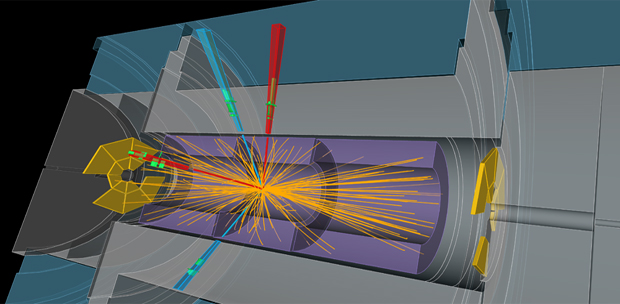Scientists celebrate Nobel for Higgs discovery

Display of a Higgs-Boson candidate event. The event was recorded on May 18, 2012. The tracks and clusters of the two electron pairs are colored red and blue, respectively.
The Royal Swedish Academy of Sciences awarded the Nobel Prize in physics today to Peter Higgs and Francois Englert for their theory on how elementary particles obtain mass — an idea which sparked the largest international scientific endeavor in history, culminating in last year’s announcement of the discovery of the Higgs boson particle.
Needless to say, the newly minted laureates are not the only ones celebrating. Thousands of scientists worldwide were involved in the experimental discovery of the Higgs — including several right here at Brandeis.
The high-energy physics group, led by professors James Bensinger, Craig Blocker, Hermann Wellenstein and Gabriella Sciolla, has been involved for nearly two decades in collaborative experiments to detect the Higgs particle in the Large Hadron Collider, the world’s largest particle accelerator, located underground near Geneva.
“For more than 40 years, particle physicists have been after the Higgs boson, grasping in the dark,” says professor Sciolla, who joined the team in 2011 and studies one of the two channels where the Higgs was discovered. “The recognition from the Nobel committee marks both an end to this saga and the beginning of a journey to understand the Higgs field.”
The Brandeis group is responsible for designing and operating a system of lasers that aligns the muon detectors, allowing a more precise measurement of the mass of the Higgs boson.
Categories: Research, Science and Technology





